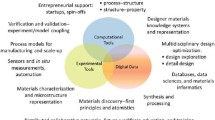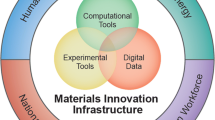Abstract
The goal of the Materials Genome Initiative is to substantially reduce the time and cost of materials design and deployment. Achieving this goal requires taking advantage of the recent advances in data and information sciences. This critical need has impelled the emergence of a new discipline, called materials data science and informatics. This emerging new discipline not only has to address the core scientific/technological challenges related to datafication of materials science and engineering, but also, a number of equally important challenges around data-driven transformation of the current culture, practices, and workflows employed for materials innovation. A comprehensive effort that addresses both of these aspects in a synergistic manner is likely to succeed in realizing the vision of scaled-up materials innovation. Key toolsets needed for the successful adoption of materials data science and informatics in materials innovation are identified and discussed in this article. Prototypical examples of emerging novel toolsets and their functionality are described along with select case studies.



Similar content being viewed by others
References
“Materials Genome Initiative for Global Competitiveness” (National Science and Technology Council, 2011), http://www.whitehouse.gov/sites/default/files/microsites/ostp/materials_genome_initiative-final.pdf.
Committee on Integrated Computational Materials Engineering, National Materials Advisory Board, Division of Engineering and Physical Sciences, National Research Council, “Integrated Computational Materials Engineering: A Transformational Discipline for Improved Competitiveness and National Security” (The National Academies Press, Washington, DC, 2008).
“A National Strategic Plan for Advanced Manufacturing” (National Science and Technology Council Committee on Technology Interagency Working Group on Advanced Manufacturing, February 2012), http://www.whitehouse.gov/sites/default/files/microsites/ostp/iam_advancedmanufacturing_strategicplan_2012.pdf.
G.J. Schmitz, U. Prahl, Integr. Mater. Manuf. Innov. 3, 2 (2014).
European Materials Modeling Council, http://emmc.info (accessed March 6, 2016).
J. Hale, Aero 4, 17 (2006).
T.W. Eager, Technol. Rev. 90, 24 (1987).
“The Materials Genome Initiative Strategic Plan” (Materials Genome Initiative National Science and Technology Council Committee on Technology Subcommittee on the Materials Genome Initiative, 2014), http://www.nist.gov/mgi/upload/MGI-StrategicPlan-2014.pdf.
“Implementing ICME in the Aerospace, Automotive, and Maritime Industries” (The Minerals, Metals and Materials Society, Warrendale, PA, 2013).
ASM International, “Materials Data Analytics: A Path-Finding Workshop” (The Ohio State University, October 8–9, 2015), http://www.asminternational.org/documents/10192/25925847/1-MDAHenry+Intro+2015-10-08.pdf/a67c84f5-4f44-48e3-b096-5a70352b338a (accessed March 6, 2016).
Georgia Tech, University of Wisconsin–Madison, University of Michigan, “Building an Integrated MGI Accelerator Network” (MGI Accelerator Workshop, June 5–6, 2014), http://acceleratornetwork.org/events/past-events/building-an-integrated-mgi-accelerator-network (accessed March 6, 2016).
“Modeling Across Scales: A Roadmapping Study for Connecting Materials Models and Simulations Across Length and Time Scales” (The Minerals, Metals and Materials Society, Warrendale, PA, 2015).
S.R. Kalidindi, Int. Mater. Rev. 60, 150 (2015).
S.R. Kalidindi, M.D. Graef, Annu. Rev. Mater. Res. 45, 171–193 (2015).
S.R. Kalidindi, Hierarchical Materials Informatics (Butterworth-Heinemann, Oxford, 2015).
J.H. Panchal, S.R. Kalidindi, D.L. McDowell, Comput. Aided Des. 45, 4 (2013).
D.L. McDowell, S.R. Kalidindi, MRS Bull. 41, 326 (2016).
D. Donoho, “50 Years of Data Science,” http://courses.csail.mit.edu/18.337/2015/docs/50YearsDataScience.pdf (accessed March 9, 2016).
C. Anderson, “The End of Theory: The Data Deluge Makes the Scientific Method Obsolete” (updated 6/23/2008), available at http://www.wired.com/science/discoveries/magazine/16-07/pb_theory.
A.J. Hey, S. Tansley, K.M. Tolle, “The Fourth Paradigm: Data-Intensive Scientific Discovery” (Microsoft Research, Redmond, WA, 2009).
E. Wenger, Communities of Practice: Learning, Meaning, and Identity (Cambridge University Press, New York, 1998).
The R Project for Statistical Computing, http://www.r-project.org (accessed March 9, 2016).
SciPy: Open Source Scientific Tools for Python, http://www.scipy.org (accessed March 6, 2016).
S.V.D. Walt, S.C. Colbert, G. Varoquaux, Comput. Sci. Eng. 13 (2), 22 (2011).
Scikit Learn, http://scikit-learn.org/stable (accessed March 6, 2016).
S. Seabold, J. Perktold, Proc. 9th Python Sci. Conf., pp. 57–61 (2010).
W. McKinney, Proceedings of the 9th Python in Science Conference (2010), pp. 51–56.
MATLAB User’s Guide 5, 333 (Natick, MA, 1998).
Project Jupyter, http://jupyter.org/index.html (accessed March 12, 2016).
Galaxy, https://galaxyproject.org (accessed March 6, 2016).
Pegasus, https://pegasus.isi.edu (accessed March 6, 2016).
KNIME, https://www.knime.org (accessed March 6, 2016).
Orange, http://orange.biolab.si (accessed March 6, 2016).
gUSE—Grid and Cloud Support User Environment, http://guse.hu (accessed March 12, 2016).
e-Science Gateways, http://www.esciencecentral.org/gateways.php (accessed March 6, 2016).
HUBzero, https://hubzero.org (accessed March 6, 2016).
Nanohub, https://nanohub.org (accessed March 6, 2016).
M.P. Krein, B. Natarajan, L.S. Schadler, L.C. Brinson, H. Deng, D. Gai. Y. Li, C.M. Breneman, “Development of Materials Informatics Tools and Infrastructure to Enable High Throughput Materials Design,” Mater. Res. Soc. Symp. Proc. 1425 (Materials Research Society, Warrendale, PA, 2012).
C.M. Breneman, L.C. Brinson, L.S. Schadler, B. Natarajan, M. Krein, K. Wu, L. Morkowchuk, Y. Li, H. Deng, H. Xu, Adv. Funct. Mater. 23, 5746 (2013).
S.R. Kalidindi, J.A. Gomberg, Z.T. Trautt, C.A. Becker, Nanotechnology 26, 344006 (2015).
D. Cebon, M.F. Ashby, MRS Bull. 31, 1004 (2006).
A. Agrawal, P.D. Deshpande, A. Cecen, G.P. Basavarsu, A.N. Choudhary, S.R. Kalidindi, Integr. Mater. Manuf. Innov. 3, 1 (2014).
Z.-K. Liu, L.-Q. Chen, K. Rajan, JOM 58, 42 (2006).
K. Rajan, Mater. Today 8, 38 (2005).
H.K.D.H. Bhadeshia, Stat. Anal. Data Min. 1, 296 (2009).
S.R. Kalidindi, S.R. Niezgoda, G. Landi, S. Vachhani, T. Fast, CMC Comput. Mater. Con. 17, 103 (2010).
P. Steinmetz, Y.C. Yabansu, J. Hötzer, M. Jainta, B. Nestler, S.R. Kalidindi, Acta Mater. 103, 192 (2016).
A. Gupta, A. Cecen, S. Goyal, A.K. Singh, S.R. Kalidindi, Acta Mater. 91, 239 (2015).
Y.C. Yabansu, S.R. Kalidindi, Acta Mater. 94, 26 (2015).
A. Cecen, T. Fast, E.C. Kumbur, S.R. Kalidindi, J. Power Sources 245, 144 (2014).
S.R. Niezgoda, A.K. Kanjarla, S.R. Kalidindi, Integr. Mater. Manuf. Innov. 2 (3), (2013), doi:10.1186/2193-9772-2-3.
S.R. Kalidindi, ISRN Mater. Sci. 2012, 305692 (2012).
T. Fast, S.R. Kalidindi, Acta Mater. 59, 4595 (2011).
J.B. Shaffer, M. Knezevic, S.R. Kalidindi, Int. J. Plast. 26, 1183 (2010).
Citrine Informatics, http://www.citrination.com (accessed March 6, 2016).
Clean Energy Project, http://cleanenergy.molecularspace.org (accessed March 6, 2016).
S. Curtarolo, W. Setyawan, G.L. Hart, M. Jahnatek, R.V. Chepulskii, R.H. Taylor, S. Wang, J. Xue, K. Yang, O. Levy, Comput. Mater. Sci. 58, 218 (2012).
CALPHAD (Computer Coupling of Phase Diagrams and Thermochemistry), http://www.calphad.org (accessed March 6, 2016).
MatWeb, http://www.matweb.com (accessed March 6, 2016).
NIST (National Institute of Standards and Technology) Data Gateway, http://srdata.nist.gov/gateway/gateway?dblist=1 (accessed March 6, 2016).
NIST Material Measurement Laboratory, http://www.ctcms.nist.gov/potentials (accessed March 6, 2016).
Open Quantum Materials Database, http://oqmd.org (accessed March 6, 2016).
Granta Design, Data Products, http://www.grantadesign.com/download/pdf/Data-products.pdf (accessed March 6, 2016).
MatNavi (NIMS Materials Database), http://mits.nims.go.jp/index_en.html (accessed March 6, 2016).
C.A. Becker, F. Tavazza, Z.T. Trautt, R.A.B. de Macedo, Curr. Opin. Solid State Mater. Sci. 17, 277 (2013).
E.B. Tadmor, R. Elliott, J. Sethna, R. Miller, C. Becker, JOM 63, 17 (2011).
J.G. Kaufman, E.F. Begley, Adv. Mater. Proc. 161, 35 (2003).
A.S. Varde, E.F. Begley, S. Fahrenholz-Mann, Proc. 4th Int. Workshop Data Mining Standards, Services and Platforms (American Association for Computing Machinery, New York, 2006), pp. 47–54.
R.D. Chirico, M. Frenkel, V.V. Diky, K.N. Marsh, R.C. Wilhoit, J. Chem. Eng. Data 48, 1344 (2003).
MDCS—Materials Data Curation System, GitHub, https://github.com/usnistgov/MDCS (accessed March 9, 2016).
Materials Commons, http://www.prisms-center.org/#/mcommons/overview (accessed April 15, 2016).
S. Chance, C. Paul, Adv. Mater. & Proc. 174, 25 (2016).
W.F. Brown, J. Chem. Phys. 23, 1514 (1955).
S. Torquato, Random Heterogeneous Materials (Springer-Verlag, New York, 2002).
B.L. Adams, S.R. Kalidindi, D. Fullwood, Microstructure Sensitive Design for Performance Optimization (Butterworth-Heinemann, Oxford, 2012).
D.T. Fullwood, S.R. Niezgoda, B.L. Adams, S.R. Kalidindi, Prog. Mater. Sci. 55, 477 (2010).
G.W. Milton, The Theory of Composites (Cambridge University Press, Cambridge, 2002).
PyMKS: Materials Knowledge System in Python, figshare, http://dx.doi.org/10.6084/m9.figshare.1015761 (accessed March 17, 2016).
ResearchGate, https://www.researchgate.net (accessed March 12, 2016).
LinkedIn, https://www.linkedin.com (accessed March 12, 2016).
J. Ahrens, B. Geveci, C. Law, C. Hansen, C. Johnson, The Visualization Handbook (Elsevier Butterworth–Heinemann, New York, 2005), pp. 717–731.
TomViz for Tomographic Visualization of Nanoscale Materials, TomViz, http://www.tomviz.org (accessed March 9, 2016).
Avizo 3D Software for Materials Science, Avizo, http://www.fei.com/software/avizo-3d-for-materials-science. Accessed March 9, 2016.
P. Cignoni, M. Callieri, M. Corsini, M. Dellepiane, F. Ganovelli, G. Ranzuglia, Proc. Eurographics Italian Chap. Conf. 2008 (2008), pp. 129–136.
ABAQUS/Standard: User’s Manual (Hibbitt, Karlsson & Sorensen, Inc., Pawtucket, RI, 1998).
ANSYS Academic Research, Release 17.0, Help System (ANSYS Inc., 2016).
S. Wolfram, Mathematica: A System for Doing Mathematics by Computer (Addison Wesley Longman, Reading, PA, 1991).
M. Uschold, M. Gruninger, Knowl. Eng. Rev. 11, 93 (1996).
B. Chandrasekaran, J.R. Josephson, V.R. Benjamins, IEEE Intell. Syst. 14, 20 (1999).
MATIN: e-Collaboration Platform for Materials Innovation, http://materials.gatech.edu/matin (accessed March 12, 2016).
Institute for Materials at Georgia Institute of Technology, http://materials.gatech.edu (accessed March 10, 2016).
Y. Koizumi, T. Kobayashi, T. Yokokawa, J. Zhang, M. Osawa, H. Harada, Y. Aoki, M. Arai, Superalloys 2004, 35 (2004).
Nickel Based Superalloy Design Model, http://mined.gatech.edu/ni_super_alloy_design/ (accessed June 19, 2016).
Generic Materials Design Toolkit, https://mgi.nist.gov/generic-materials-design-toolkit (accessed June 19, 2016).
Materials Knowledge Systems in Python, http://pymks.org (accessed June 19, 2016).
Acknowledgments
S.K. and D.B. acknowledge funding from NIST 70NAN-B14H191 for this work. D.B. also acknowledges funding from NSF-IGERT Award 1258425. A.C. acknowledges funding from AFOSR Award FA9550–12–1-0458. A.B. acknowledges support from the GT-IDEAS project and GT-IMat for the MATIN development.
Author information
Authors and Affiliations
Corresponding author
Rights and permissions
About this article
Cite this article
Kalidindi, S.R., Brough, D.B., Li, S. et al. Role of materials data science and informatics in accelerated materials innovation. MRS Bulletin 41, 596–602 (2016). https://doi.org/10.1557/mrs.2016.164
Published:
Issue Date:
DOI: https://doi.org/10.1557/mrs.2016.164




